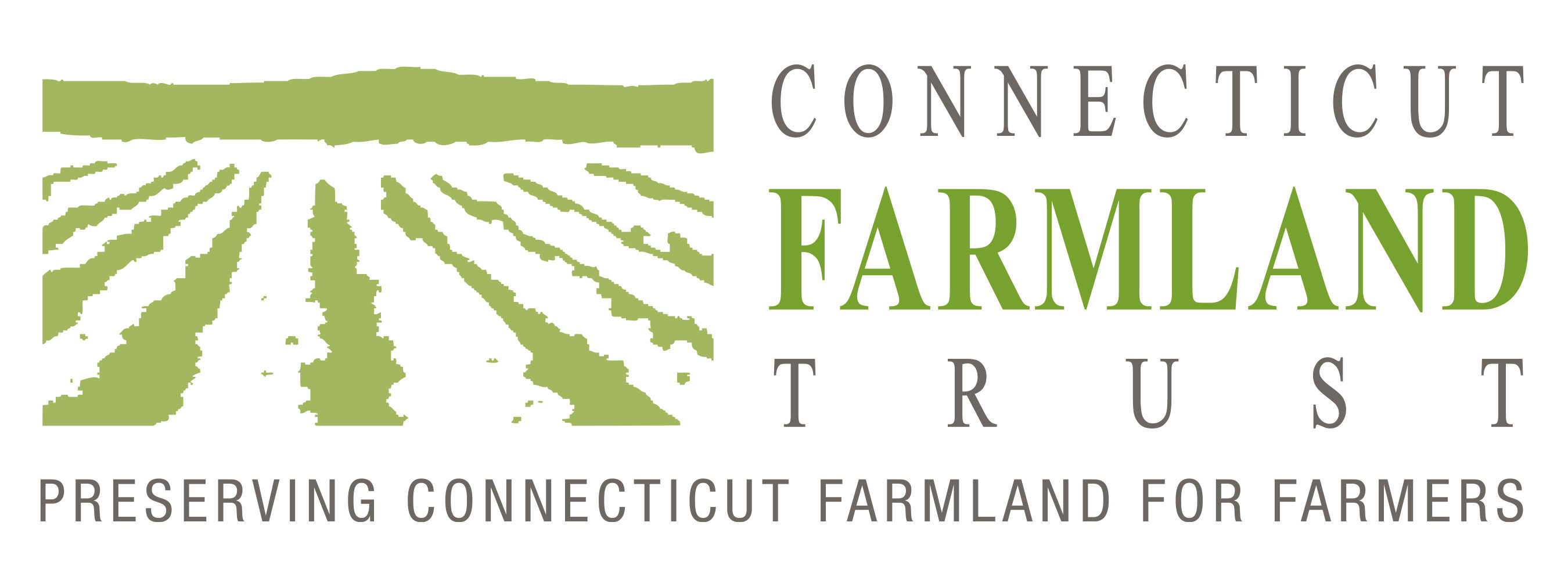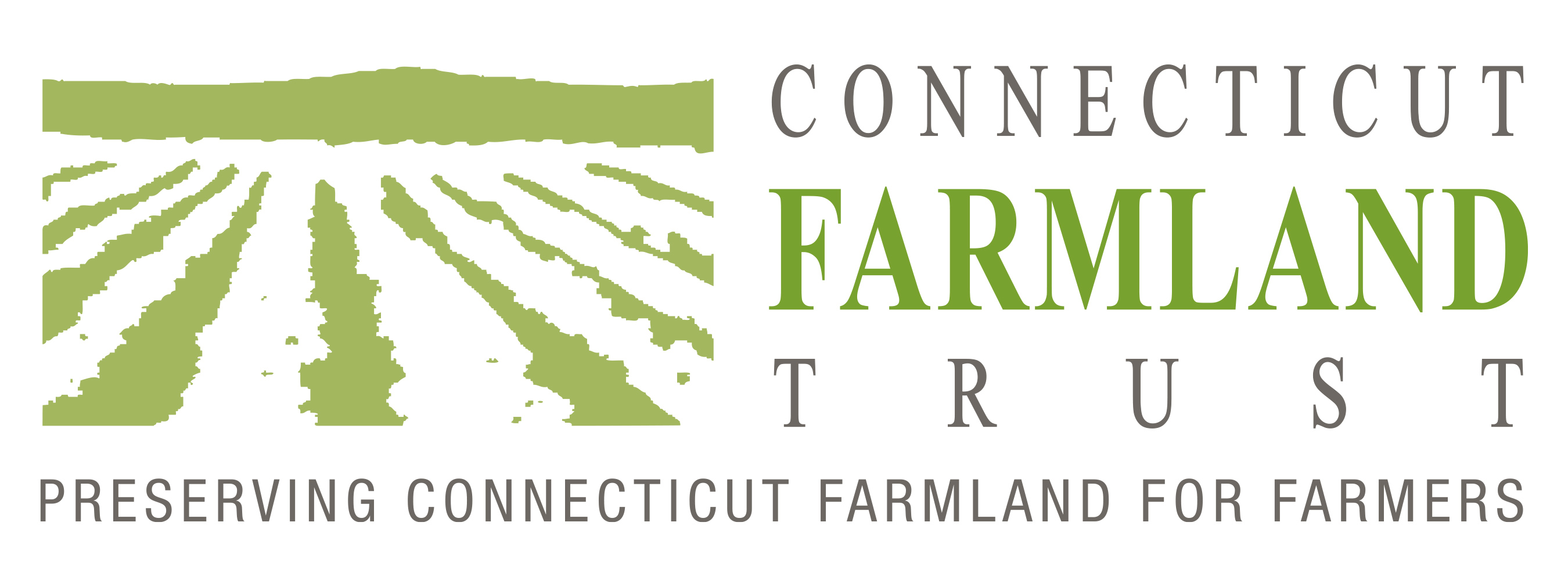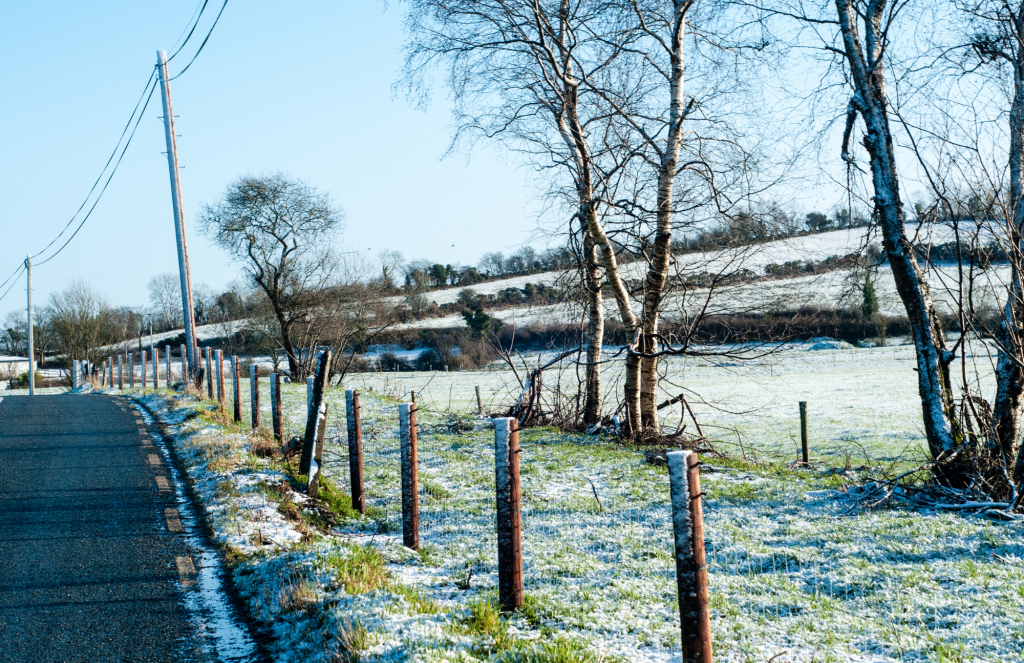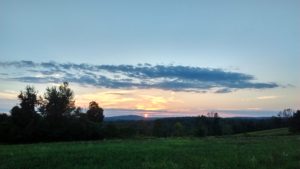Featuring contributions from Connecticut Farmland Trust staff members

Farm Visit in Bolton
by Maddie Dres, FarmLink Associate May 26, 2022
We had a great site visit last week in Bolton with our new intern Rachael! It was a gorgeous day to be outside walking the boundaries of a farm that will be protected this year. We saw gorgeous wildflowers, a deer, a snake, and a mysterious sign in the middle of the woods. When further researched we learned it means that there is a nearby school area… which was untrue. Welcome to the team, Rachael!

Spring Wild Flowers
by Kathleen Doherty, Conservation Manager May 12, 2022
During visits to farms, CFT staff have a wide variety of experiences – everything from inspiring, funny, and educational, to even a bit scary (not often). Our Conservation Manager Kathleen Doherty shares her #notesfromthefield from a recent site visit.
“Spring wildflowers are here! My plant ID skills are not the best, but I can’t resist taking photos of these tiny flowers on the forest floor when I’m out visiting farms. Known as “spring ephemerals” because of their short flowering window, these plants leaf out and bloom before trees in the canopy have enough leaves to shade the forest floor. Luckily for me, I found an app to help ID these plants. Do you have any guesses?”
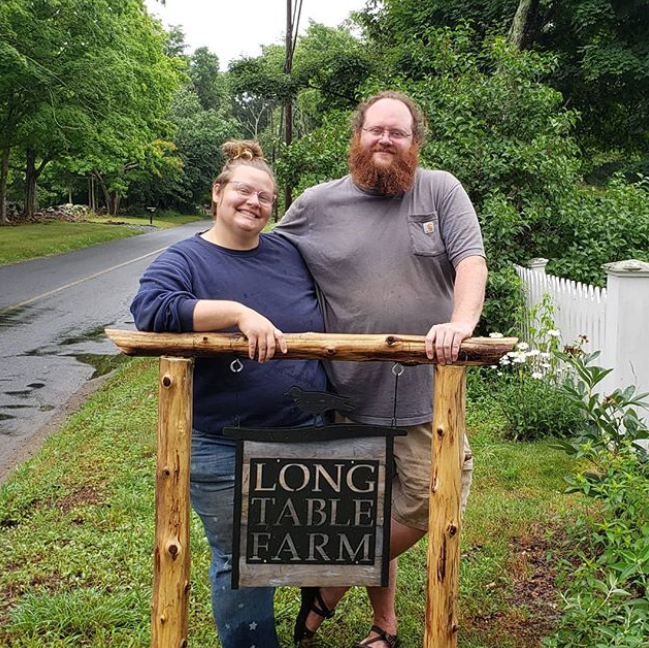
The Evolution of Long Table Farm, 2020 Special Edition Story
by Brianna Dunlap, Development and Communications Manager
The transformation of New Mercies Farm in Lyme, protected by Connecticut Farmland Trust (CFT) in 2017, to Long Table Farm involves three different farm names, two different couples, and one happy community.
Deborah, a sculptor, and Rod, a physician, are lifelong organic gardeners, but they are not lifelong farmers. That did not stop them from acting on their love and respect for farming.
Years ago, the Deb and Rod Hornbake bought a plot of land that was the former site of a colonial-era homestead. The historic home on the property burned down, and the previous owner decided not to rebuild, but to sell. The couple intentionally bought the land to conserve it and make a farm. If they had not purchased it, the land would have been used for several homesites. Upon this land, the Hornbakes applied time, soil science, community assistance, and love. They created a farm where none had been before.
The Hornbakes founded New Mercies Farm in 2012 with the mission to preserve land for agricultural use; to provide wholesome food for the community; and to provide opportunities for young farmers to be successful in their chosen field of endeavor.
The Hornbakes honored that mission by leasing the land to a young farming couple in 2016. Baylee Drown and her partner Ryan Quinn have since bought the farm with the help of a CFT conservation easement. “We could not afford to purchase New Mercies without the easement,” said Baylee. Now, she and Quinn are heading up a thriving farm business on the land.
From Upper Pond to Long Table
Baylee Drown grew up on a conventional dairy farm in Michigan. While earning her BS in Animal Sciences, she took an animal ethics course that changed her life course from conventional farming of animals to a deep dive into organic, sustainable plant-based farming.
Baylee came to Connecticut to take a job as a farm manager and ended up leasing the land to start her own business, Upper Pond Farm, in 2013. Baylee and her partner Quinn chose to manage the new fruit and vegetable farm with sustainable, holistic methods. They rapidly had families sign up for seasonal, weekly CSA boxes (also known as community-supported agriculture subscriptions), and the happy customers kept on coming!
Quickly, Baylee and Quinn realized that they needed more land with housing for the venture. “We started to look for a farm that we could afford to buy in the Old Lyme region,” said Baylee. When they were introduced to the Hornbakes by chance at a farm dinner, the two couples quickly saw the potential for collaboration. In 2017, Deborah and Rod donated a conservation easement on their 4.6-acre farm to CFT. The preserved acres comprise the smallest farm CFT has protected to date.
Once New Mercies Farm was officially preserved, the Hornbakes began the process of selling the farm to Baylee and Quinn. Access to land is a major challenge facing beginning farmers, and conservation easements help them meet that challenge. By prohibiting nonagricultural development, conservation easements reduce a property’s value and make the land more affordable for beginning farmers.
Long Table Farm has been growing! Pun intended. After they completed the purchase of New Mercies Farm in 2019, Baylee and Quinn asked the 250 families who have a CSA subscription with the farm to vote on a new name for the entire business. Long Table Farm, covering both the Upper Pond and old New Mercies plots, and two Lyme Land Trust properties, was born later that year.
“We have a model that is good for the land, for the food that we grow, for the community,” said Baylee, this summer. “We are diversifying to animal products. There is a call from our community to supply sustainable meat, and we have pigs on the farm as part of a healthy, closed-circuit way of preventing food waste.” For Long Table Farm, the connection is clear – they can offer pork products that are in-tune with their land’s natural cycle. “We are actively engaged in the community – woven into the community. They appreciate the sustainability of the farm and want us to stay.”
When asked about what Baylee and Quinn have accomplished with the Long Table Farm business, and the land, Deborah Hornbake said, “[Baylee and Quinn] have grown the business very successfully. For me, the bottom line is that what happens after the land is protected depends upon the care you take in selecting the right farmers with the right skills, instincts, motivations, and goals.”
For the broader picture future of farming in the area, Baylee enthused, “the food can system get tighter and more local. What I want to see is more and more hyper-local, sustainable vegetable farms that are owner-operated. If you know how to do it, you can produce an immense amount of food on very little acreage.” She noted that Connecticut has an ideal set-up for direct marketing because of the state’s mix of urban, suburban, and rural regions. “Other states do not have this dynamic geography – farmers can benefit from this.”
Baylee and Quinn invest in the care of the land and in the quality of food that they produce. In turn, the people of their community invest in them – as it should be. The future of Long Table Farm is bright, and as a CFT supporter, you should be proud that you have helped to make this evolution possible.
If you live in the Lyme and Old Lyme region, be sure to check out Long Table Farm!
Okay, Farm!
by Kathleen Doherty, Conservation Coordinator
For many farmers, preserving their land gives them the peace of mind that whatever other changes may come in the future, their farm will remain the same.
During a recent closing, after the documents were signed and the land preservation deal was set in stone, I heard landowner “Stacey” express this newfound peace of mind: “When I got home, the first thing I did was say to the farm, ‘Okay, farm, you’re all set! Your fields and trees are protected forever.’” This verbal declaration to the land itself proves just how deep a connection to land can be. The protection of this farm seems to be legal and a bit spiritual, too.
Once the legal formalities of the “closing,” or the conclusion of a farm preservation project, were out of the way, I drove over to the landowner’s house to celebrate the preservation of the farm with “Stacey” and her husband. Our tradition at CFT is to celebrate each protected farm with a pie or crisp featuring local Connecticut fruit, so the three of us enjoyed an apple crisp together and swapped farm stories and baking tips. Thanks to CFT, the farm is “all set” to continue as a farm, forever. November, 2019.
The Farm Bill
by Kathleen Doherty, Conservation Coordinator
Sometimes, farmland preservation can seem like an uphill battle.
The high land values in Connecticut and limited preservation resources for conservation means that CFT must actively utilize all available funding to protect the farms and forests that improve our quality of life. In order to do this, CFT pursues partnerships with federal, state, and local government agencies, as well as local land trusts, to leverage all available funding sources. Doing this makes your donations go farther.
One important source of national funding for farmland conservation is the Farm Bill, which has historically had bipartisan support, is up for renewal this year. Learn more about the Farm Bill 2018 updates here. Another source, from the State, is the Connecticut Department of Agriculture, whose funding has luckily survived the recent state budget uncertainties. CFT has been working hard to leverage these federal and state funding sources to protect farms that might not otherwise be protected.
The fight for state and national funding is worth it each year because diverse farms, ranging from a 500-acre dairy to a 30-acre pick-your-own pumpkin operation, across the state will benefit this year from CFT’s creative partnerships to fund farmland conservation.
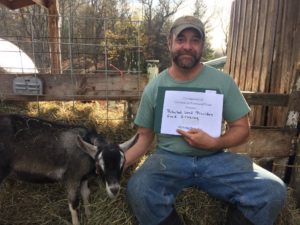
Paul Trubey, Beltane Farm
Pickled Goats Ears
by Kathleen Doherty, Conservation Coordinator
As a new staff member at Connecticut Farmland Trust, I’ve had to hit the ground running this fall. My first task as the Conservation Coordinator is for me to visit every farm on which we hold an agricultural easement. After a farm is preserved by Connecticut Farmland Trust (CFT), we visit it to see how the land is doing and checking to see if the land owner is complying with the terms of their easement. All the CFT-protected farms must be visited before December 31st of each year. In a period of less than two months, I will visit all of CFT’s forty-two protected farms.
From a tiny 5-acre vegetable operation to 250+ acre dairies, the farms that CFT has protected are remarkably diverse. Some farms sell their products directly to consumers through a CSA or farm stand. Some produce timber products and maple syrup as well as field crops. Some grow hay and corn to support a neighboring dairy farm. Some farms produce cheese and other products right on the farm. Still others are owned by local land trusts and used for public recreation as well as agriculture.
One particularly memorable visit was to Beltane Farm in Lebanon. Not only did I get to sample some delicious goat cheese, I learned that goats are incredibly smart creatures—way smarter than most people realize. They all know their names, and they come when they’re called!
I also learned that some breeds of goat are born without ear flaps – although the farmer likes to joke that pickled goats’ ears are for sale in the store (they are not). And I made friends with two donkeys whose job is to scare the coyotes away from the goats.
I can’t wait to visit the rest of the beautiful farms across the state that have been protected by CFT!
Stone Wall Dairy Farm, West Cornwall. 2007.
A Story of Giving
by Brianna Dunlap, Communications and Development Coordinator
Sometimes a moment can knock your socks off.
CFT always has an outreach table at the annual Plant Science Day in Hamden, CT. Throughout the day we get to chat with peers in our field, engage inquisitive agricultural students and sometimes we meet long-time farmland preservation enthusiasts.
One such enthusiast walked by our table-top display and her eyes lit up. She approached the display and gushed that she had been supporting CFT since the very beginning, in 2002. She shared that her childhood time spent on her grandfather’s family dairy farm connected her to our mission of protecting farmland.
Even more touching was that fact the she transformed a CFT Christmas card into a fridge magnet. The photograph on the card was of a smiling grandfather and granddaughter standing with cows in a rocky field. That photograph reminded the woman of herself back in her youth.
That’s what did it. The fact that a person had taken a card that we had mailed out years ago and placed it on the refrigerator (where is still is) because the image struck a personal cord, was deeply humbling. That truly was a “knock your socks off” moment.
Supporters of farmland preservation are a special group of people and that conversation was a reminder that each supporter has a unique story of why CFT matters. You all come from different walks of life but, unify over a common cause that binds us together.
Thank you for supporting the protection of family farms in Connecticut.
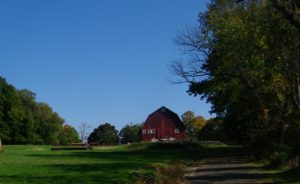
Back Roads
by Brianna Dunlap, Communications and Development Associate
Have you ever been for a drive and simply loved what you saw? A few times this month I had the chance to hop in my car to head off to farms for Connecticut Farmland Trust business.
There was one day that stands out in how spectacular it turned out to be. It was a Tuesday and I had to stop by a farm in Lebanon to interview the owner and then drop off a document to another farmer in the same town. The sky was overcast but it was a bright spring day nonetheless. From the highway, it was clear to see that trees were beginning to unfurl their leaves under the filtered sunshine. The scenery became even more awe inspiring as the drive took me to the more rural parts of the state.
My Honda Accord is not meant for bumps and windy backroads, but I am. Much to my delight the GPS took me from pavement to a muddy dirt road that snaked through fields and around barns to arrive at the historic farm. The sights were lovely enough to warrant slowing down to a crawl (which was fine since no other cars were in sight).
Yes, this is a roundabout way of saying, “it’s not the destination, it’s the journey.” Even still, it’s nice that we get the pleasure of such clichés while we serve the greater good of saving farmland.
Spirit and Technology
by Brianna Dunlap, Communications and Development Associate
My first memory of a corn field is from my childhood in Bethlehem, Connecticut just after the stalks had been harvested.
There was, and still is, a cornfield across the road from that house on Nonnewaug Road. My father (not a farmer) would go out to the field to meditate in the empty expanse before sunset, then return to the front porch to watch coyotes slink from the woods at dusk to sniff out his lingering scent. This recollection has spiritual undertones of a connection to the earth and its creatures.
Two decades later I find myself still enchanted with farming. In fact, I am struck by the technology of corn harvesting.
For millennial farmers of today, the most notable change to their operations has been technology. The changes have been in every aspect of their business. This includes seemingly small benefits such as Google and social media, to large upgrades in equipment used for milking and planting feed corn.
One owner of a large dairy (who grows corn for cow feed) in eastern Connecticut explains that new tractors offer a number of new bells & whistles including a beneficial feature that helps him monitor the yield of his combines and corn choppers. The new technology enables him to know exactly how many tons he’s harvesting per acre as he drives through his fields.
Technologically speaking, the farmers of today are not following the same path that their agrarian predecessors carved. Yet, many farmers feel attuned to the energies of the earth around them. As do the people who love the sight of a cornfield at sunset- like me.

A Time for Everything
by Danielle Breakell, Conservation and Outreach Associate
January in Connecticut comes with dull, cloudy skies and dark, cold evenings. Although fields are often sleepy and quiet, covered by blankets of snow, the farmers are hard at work as always.
In the brisk months, farmers take extra care to keep their animals warm and well-fed while grass is sparse. Some welcome lambs in the dark of the night, keeping them safe from the cold, the snow, the sleet and rain (and of course the inevitable mud).
Others work on plans for the spring, considering which seeds to plant and making lists of tasks to be completed once the ground is soft and the warmth is sure to stay. Greenhouses are cleaned and prepared, tractors are repaired, and tools are mended.
While some attempt to shrink their inevitable piles of paperwork, others sell the remnants of last year’s harvest. Grains, apples, potatoes, and other crops can last for months if stored properly.
Farmers are always working behind the scenes. There is always more planning to be done, more work waiting.
Interested in hearing it straight from a farmer? Check out what Jones Family Farms is up to this winter here.
Family Ties
by Danielle Breakell, Conservation and Outreach Associate
I grew up in an old pasture, where my parents built our home on a chunk of land carved out of my grandparents’ farm. A dairy during my father’s childhood, the barn and buildings across the street held pigs and beef cattle during mine.
As a child, I climbed the gates, where pigs chewing on the toes of my boots. I covered my ears against the chorus of hungry squeals that broke out at the sound of grain doled out. I visited the old white farmhouse, staring at the old photographs of the barns on fire, huge plumes of smoke rising in the air, and tried to The calls of the cows in the fields across the road in the morning became commonplace (as did the smell of spread manure, at times).
Moving away to college was a culture shock. Suddenly I was surrounded by cities, and pavement. I worked in the dining hall, watching as chefs prepared massive batches of food. I also watched as a lot of that food, instead of being thrown away, was gathered into huge rubber garbage bins to be shipped off to feed the pigs at local farms.
I found myself surrounded by food, pig buckets, and concrete, but remembered the fields, the squeals, and the openness of the farm. For the first time, I started to really think about the future of the land across the street from my childhood home. When it came time to work on my senior capstone project, I decided to think about the future of the farm, and farms around the state.
On November 11th, 1987, my grandfather sold the development rights to the farmland where he raised eight children. I wasn’t even born yet. Twenty-three years later, I sat across from him at his kitchen table, and he taught me about farmland protection. He told me the history of the farm, the history of his extensive career (he served as the Executive Director of USDA/FSA), and gave me names of people to contact to learn more. I drove from his house to farms around the state, interviewing farmers who had protected their farmland, and those who hadn’t, curious about their stories and their lives.
My grandfather passed away a few months before I completed my capstone project. I will always be grateful that I had the opportunity to sit at his kitchen table with him before he left. His obituary requested that donations in his name be made to the Goshen Land Trust or Connecticut Farmland Trust. Five years later, I started working at Connecticut Farmland Trust. A meandering path led me here, working among the same people, with the same goals, as he did years ago.
Thanks to my grandpa, the farm will always live on. Maybe not as he envisioned, but surely as some new farmer will. Every day, we are working to make sure that other farms have the same future.
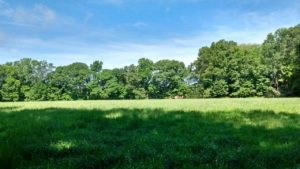
Don’t Do Donuts
by John S. Weedon, Conservation Manager
Connecticut Farmland Trust (CFT) just closed on the purchase of an agricultural conservation easement on a 34-acre farm in Lebanon. We are grateful to the landowners, the Town of Lebanon, and the United States Department of Agriculture for making the project possible. Scooter Hill Farm is preserved as farmland forever.
Now comes the real work.
CFT holds easements on 37 farms. Every autumn, we visit all 37 farms to ensure that the terms and conditions of the easement are being observed. It is a wonderful experience. We talk with the landowners about what has happened on their farms since the last visit and engage in one way chit chat with their horses, pigs, chickens, or cows. My favorite part is walking the entire property: fields, woods, wetlands. To tramp across a field with the sun warming your limbs and see the red-tailed hawks gliding across the sky is a blessing to one’s spirit.
When landowners ask why we walk their farm every year, I like to joke that I want to make sure they haven’t built a Dunkin’ Donuts. They laugh, and I smile. It’s all good.
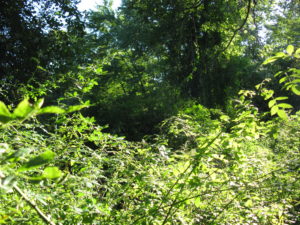
September 2016 – Gadgets in the Field
by John S. Weedon, Conservation Manager
A successful land conservationist must possess a wide breadth of knowledge, excellent people skills — and lots and lots of gadgets.
For every farm we protect, we have to complete a baseline documentation report. The report is a snapshot of the farm at the time it is protected. In a baseline you will find maps, descriptions of the property, and many photos. This provides documentation in case of a dispute in the future. For example, if a future landowner builds a Walmart on the farm, Connecticut Farmland Trust can refer to the baseline to show the landowner that the box store wasn’t there when the land was protected and is not permitted.
The other day I was out at a farm to prepare a baseline. Around my neck was a camera, compass, and GPS unit. In my right hand was a clipboard. In my left hand was a map of the farm. In the end I took 64 photographs of the farm. For each photo, I had to find the location on the map, take a picture, determine the photo’s orientation, and mark the latitude and longitude on the GPS unit. I also recorded the photo number and orientation on the pad of paper on the clipboard. Obviously, I could have used more hands.
As well-equipped as I was, I was missing one tool. A machete. In the woods on the farm was a jungle of invasives—barberry, bittersweet, and other nasty species. I could have something to help whack and hack my way through the woods. Instead I ducked, bobbed, stumbled, and gingerly pushed through the thorny bushes. My t-shirt took the brunt of the damage.
So, the next time my boss asks what supplies we need to order from Staples, I am going to raise my hand: a machete with an owner’s manual.
August 2016 – WRONG
by John S. Weedon, Conservation Manager
Most of us have seen the phrase on t-shirts or in fortune cookies or heard it in hackneyed movie dialogue:
The journey is more important than the destination.
Placing a voluntary land agreement or easement on a farm is in many ways similar to a thousand mile journey. There are so many steps that Connecticut Farmland Trust (CFT), funding agencies, lawyers, surveyors, town officials, and landowners have to take – together or separately – to create an easement. Some of the steps involved include researching land records, surveying the property, revising the survey, writing grant applications, revising grant applications, writing configuration letters, creating farmland soils maps, visiting the farm, talking with landowners, hiring attorneys, resolving boundary disputes, filling out federal and/or state forms, and so on. Each step is critical to completing the journey and rarely can you skip a step. It is all connected. Yet, unlike what the phrase claims, the destination is truly the most joyful moment in an easement project.
Recently, CFT staff had the immense pleasure of attending ceremonies where landowners signed documents that guaranteed their land will remain a farm forever. There were the elderly Carrington sisters-in-law, whose deceased husbands made it known that they wanted their land to be farmed forever. There was the Gunther family, whose father loved the land and would have been deeply touched to know his legacy will continue forever. These are the moments when paying attention to all those mind-numbing, minutiae details pays off. The best part? Our collective efforts can never be reversed, overturned, or set aside. The easements are forever. Now, that is a special kind of journey.

June 2016 – Time
by John S. Weedon, Conservation Manager
Trite statements are trite because they are true. Pick up a paper or magazine or read a blog post and you will read a commentator bemoaning the fast pace of society. Everyone wants instantaneous gratification we are told. We need to slow down we are warned. This old saw is repeated so often the message is lost.
The land trust business is far from immediate indulgence. Putting together a voluntary land agreement with a landowner that prevents development and promotes family farms takes time. Lots of time. Deals require surveys, title insurance, title review, baselines, easements, letters, phone calls, site visits, and fundraising. From start to finish, CFT projects can take up to two years and longer for complex situations.
Some might suggest the process takes too long. Certainly, we are constantly on the lookout for ways to expedite the process. But, everyone – landowners, funders, CFT staff – need to never forget that the voluntary land agreements are forever. So, if the process takes a little longer, that extra time to get it right is well worth it because perpetuity is a very, very long time.
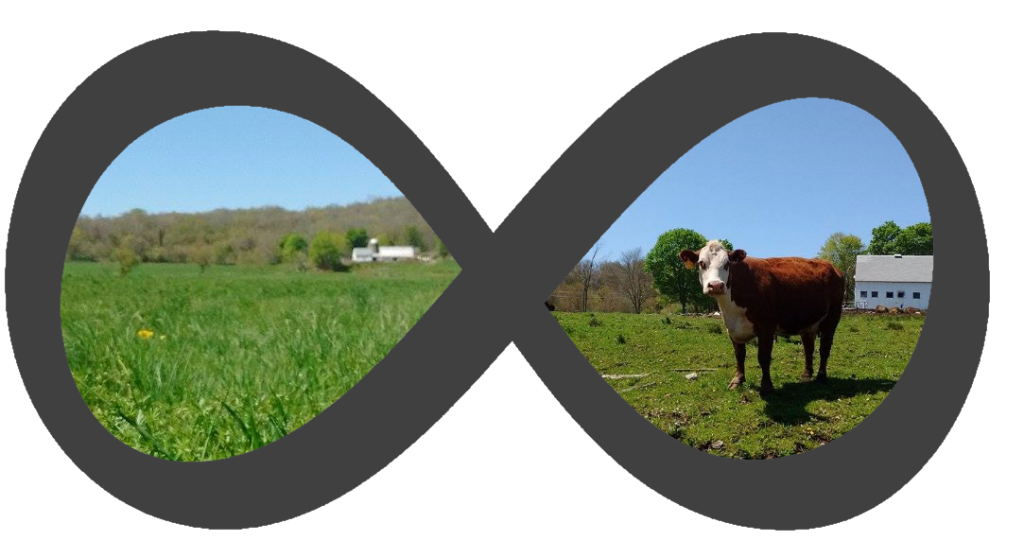
May 2016 – Getting Run Over by a Bus
by John S. Weedon, Conservation Manager
If you are in the land trust business, one of your favorite words is perpetuity. Other than lawyers and Jeopardy contestants, most people don’t use the word in every day conversations. But, for us, it is a misty eye idea.
According to Merriam-Webster, it means “the state of continuing forever or for a very long time.”
When my mom and I protected our family farm in Parkman, Ohio, one of the reasons it meant so much was because the voluntary land agreement we signed with the state and a local land trust is forever. No matter how many times the Reservation Farm changes hands from one owner to the next, the land will never ever be developed for housing subdivisions, strip malls, gas stations, or commercial business parks. In a world of constant change, this sense of permanence is comforting and reassuring.
Obviously, when a land trust makes a commitment in perpetuity, it must remain fiscally responsible and organizationally sound year in and year out. A key component to remaining business fit is to find and retain knowledgeable staff. So, just as we must keep raising money and adhering to national standards and practices, we must keep great staff.
At CFT I am responsible for assisting the executive director with farmland projects, working with landowners we already have agreements with, and, perhaps most important, sharing with my newest and younger colleague what it takes to be a successful land conservationist. By training Danielle I am helping provide the continuity necessary for the organization so that we can ensure the voluntary land agreements we have with our farmers remain intact and in compliance.
My 6th grade science teacher once told us that our experiment notes should be good enough so that if you were run over by a bus someone could step in and conduct the experiment. I know. That is a weird thing to say to a bunch of 11 year olds.
I am confident that if I were run over by a bus Danielle could pick up the pieces and help continue our mission of preserving farmland for this and future generations. That is perpetuity at work. And it is a beautiful thing.
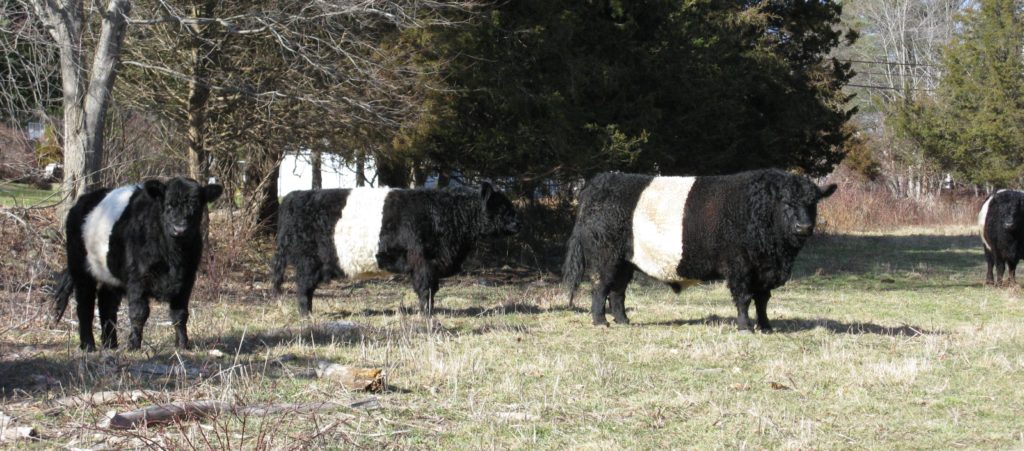
April 2016 – Avoiding the Bull
by John S. Weedon, Conservation Manager
One of Connecticut Farmland Trust’s obligations is to ensure the terms of voluntary land agreements are being honored at each of our partner farms. Among other things, we visit the farms once a year to make sure everything is as it should be. Sometimes, you have unexpected encounters.
I was walking the fields of one farm the other day and was looking forward to meeting up with the farmer’s herd of cows. I spent summers on my grandfather’s dairy farm and enjoyed the challenge of trying to get the cows to come up to me so I could pet them. Usually they got within a few feet before lumbering away. Humans are much less interesting than forage.
I knew the cows were around because I kept dodging manure piles. I was coming down one of the sloped fields when I finally spied them. It took my brain a moment to register the situation was in.
Trouble.
The herd of Belted Galloway cattle looked up from grazing and stared. None of them moved. And then a bull, weighting around 1,700 pounds, started moving towards me. I inched my way to the barbed wire fence bordering the field. I quickly realized leaping over the fence entangled densely with bittersweet and vines was a lousy option. I would become easily ensnared and a tempting target for an angry bull defending his harem. I threw up my hands and shouted to show how large and dangerous I was. Right. The bull kept moving. I was down to my last option. If I tried, I might make it. At the moment I had enough distance to make a run for it to the barn. Waiting would only shorten the distance between me and over 1,000 pounds of muscle. I looked for the shortest distance to the barn, threw out a few more shouts and yells – more to steady my nervous than to scare the bull – and started speed walking across the field. I didn’t look back, thinking I would hear the hooves bearing down on me with little effort. I was about a hundred feet from the gate when I peeked over my shoulder.
Nothing. The bull and cows were gone.
I took a deep breath and sauntered to the gate. All that and nothing. As I was climbing over it, I felt the ground tremor. I looked back. The herd with the bull in the lead thundered over the knoll and raced towards the barn and me. I quickly scrambled over the fence. It was only after I had a barbed barrier between them and me could I step back and admire their strength and size. Magnificent animals.
I got in my car and filled out the monitoring form for the farm. Yes, everything on this farm was as it should be.
Recommended Movie: All is Lost
